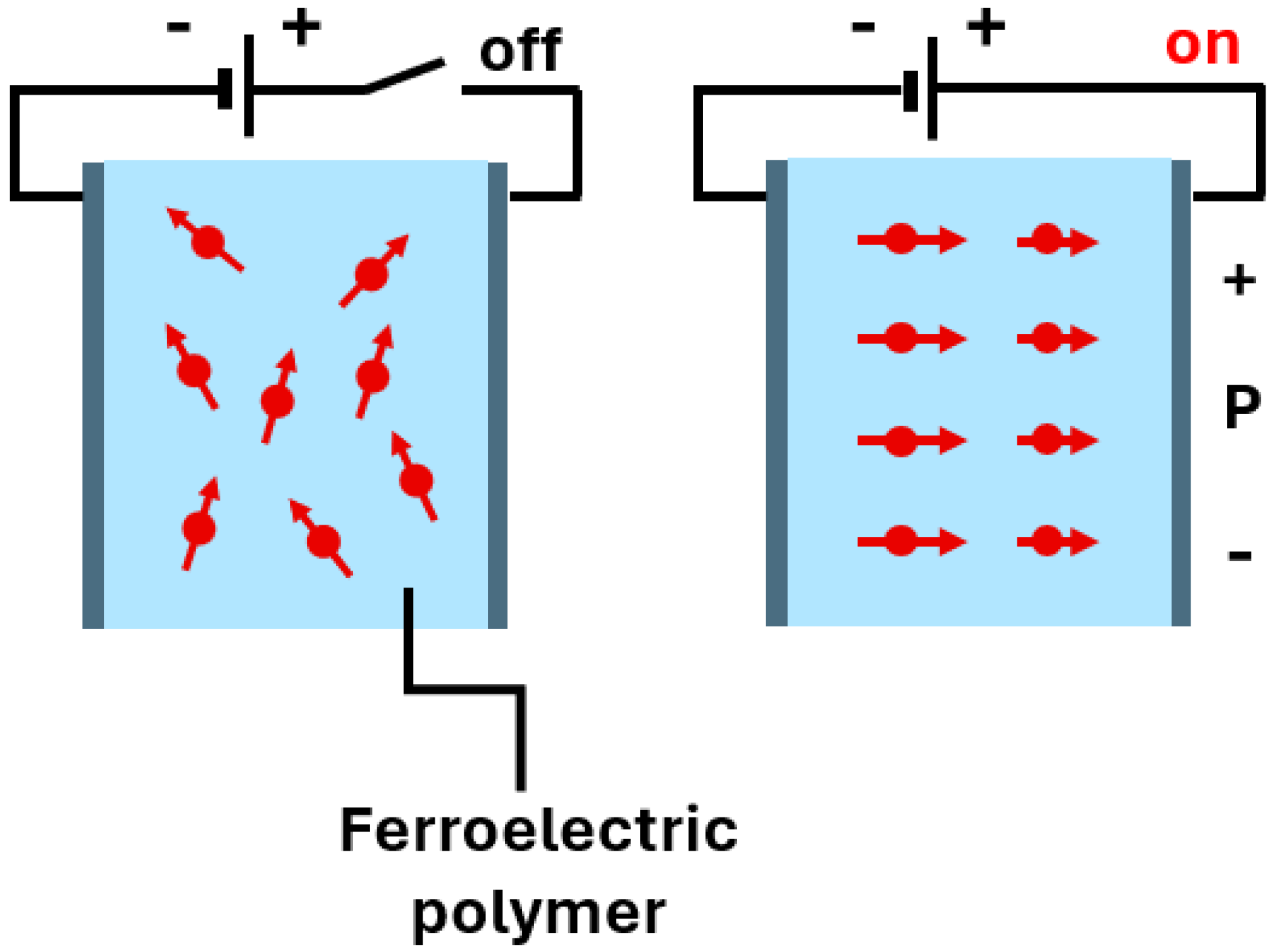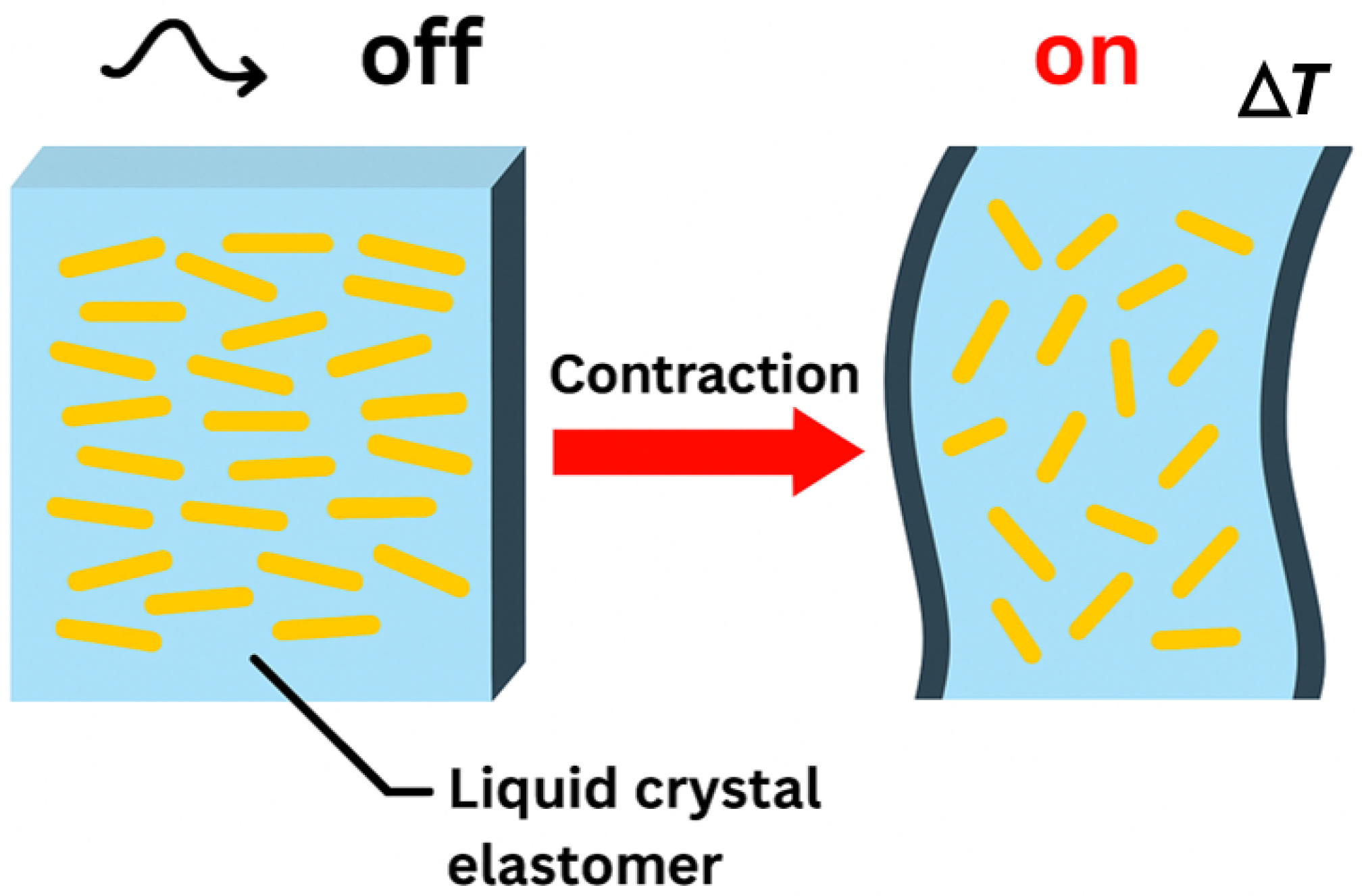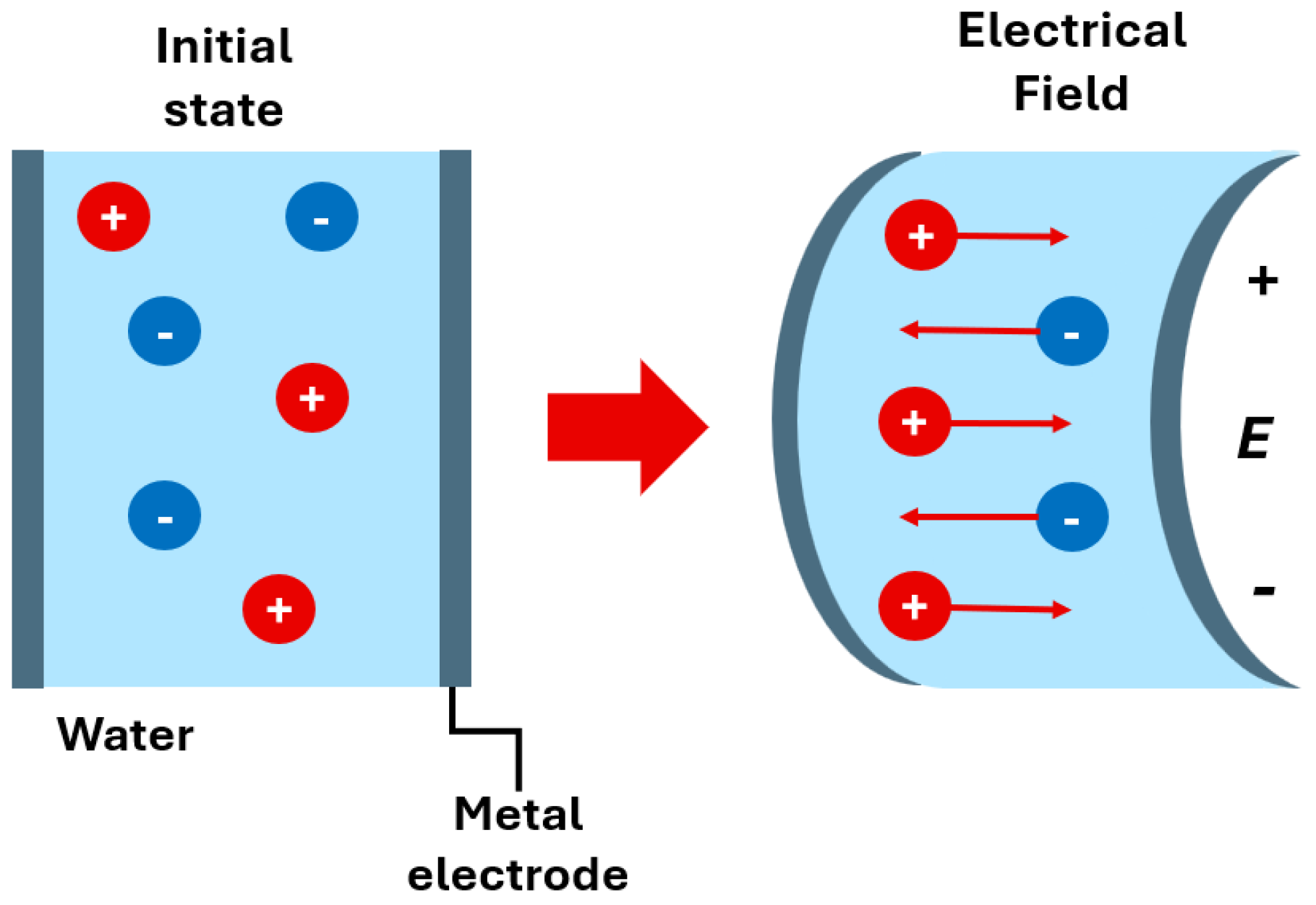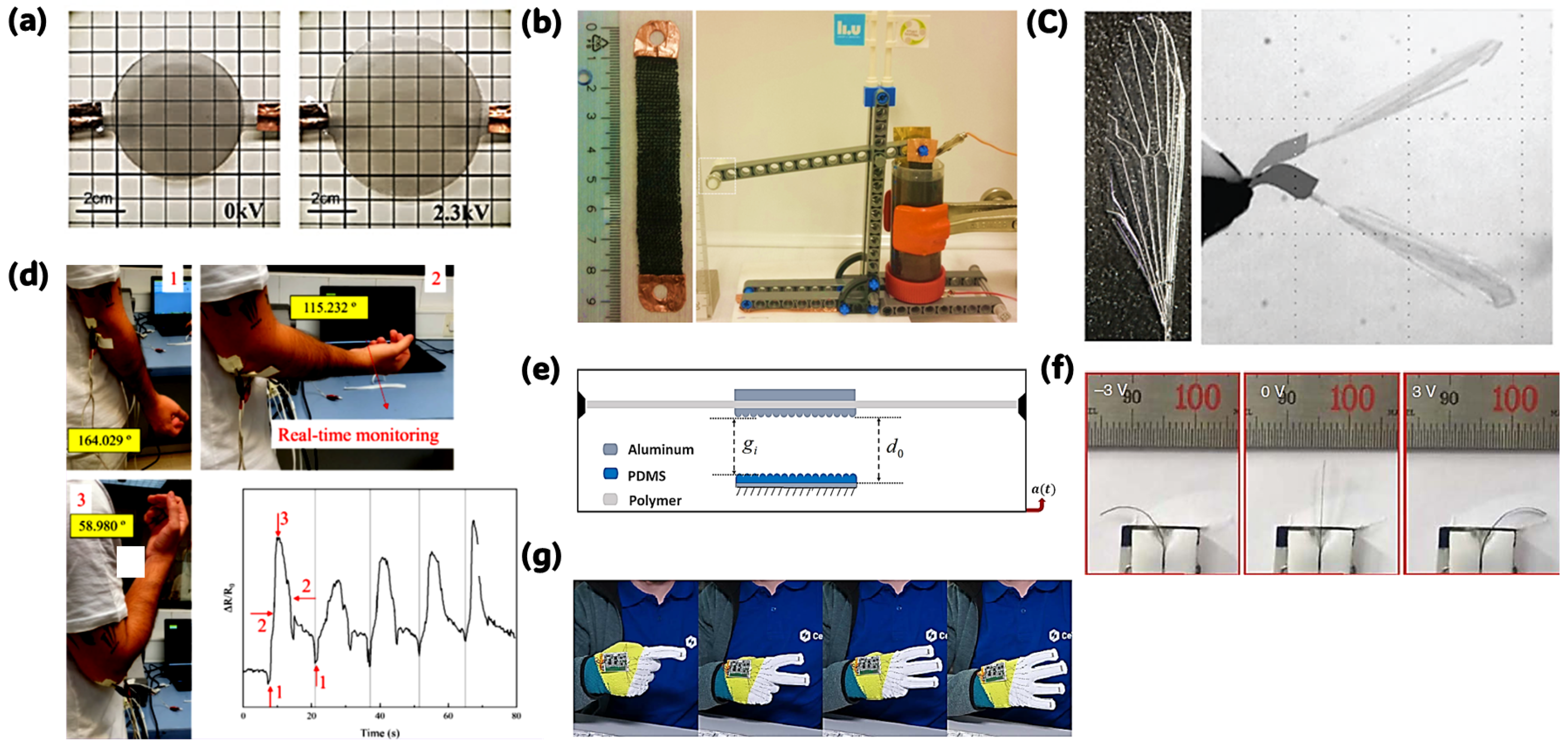A Review of Electroactive Polymers in Sensing and Actuator Applications
Abstract
1. Introduction
1.1. Background and Importance of Electroactive Polymers (EAPs)
1.2. Historical Development of EAPs
- 1899: Sacerdote introduced the first engineered electric field-based strain response [9].
- 1925: Eguchi discovered the first piezoelectric polymer, Electret, composed of rosin and beeswax solidified under a DC field [9].
- 1970s–1980s: Introduction of Ionic Polymer-Metal Composites (IPMCs) and conductive polymers, enabling low-voltage actuation [12].
1.3. Classification of EAPs
1.3.1. Electronic EAPs (Field Activated)
1.3.2. Ionic EAPs (Ion-Activated)
1.4. Importance of EAPs in Modern Technology
2. Materials and Methods
2.1. Dielectric Elastomers
2.2. Ferroelectric Polymers
2.3. Liquid Crystal Elastomers (LCEs)
2.4. Ionic Polymer-Metal Composites (IPMCs)
2.5. Conducting Polymers (CPs)
2.6. Ionic and Polyelectrolyte Gels
2.7. Current Landscape of EAP-Based Actuation
3. Sensing Applications of Electroactive Polymers (EAPs)
- Piezoelectric response: Ferroelectric polymers such as PVDF and P(VDF-TrFE) generate voltage upon mechanical deformation due to dipole realignment in the -phase. Nanostructured fillers like ZnSnO3 and BaTiO3 further enhance piezoelectric output by increasing crystallinity and interfacial polarization [10,66].
- Chemiresistive and electrochemical sensing: Conducting polymers such as PEDOT:PSS, PPy, and PANI exhibit changes in conductivity via redox or doping/dedoping reactions when exposed to biochemical or gaseous analytes. This mechanism underlies biosensors for glucose, lactate, dopamine, and common environmental pollutants like NH3 and NO2 [53,60,65,67].
- Hybrid multimodal systems: Recent nanocomposite platforms integrate PEDOT derivatives with graphene oxide, CNTs, or metal oxides such as ZnO. These systems enable simultaneous multi-parameter sensing in wearable or epidermal formats and often incorporate AI-enabled signal analysis pipelines [7,64,69,71].
3.1. Biomedical and Wearable Sensing
3.2. Tactile and Haptic Interfaces
3.3. Soft Robotics and Self-Sensing Actuators
3.4. Environmental and Structural Health Monitoring
3.5. Advanced Platforms, Challenges and Future Directions
4. Conclusions
Funding
Conflicts of Interest
Abbreviations
| EAP | Electroactive Polymer |
| DEA | Dielectric Elastomer Actuator |
| IPMC | Ionic Polymer-Metal Composites |
| LCE | Liquid Chrystal Elastomer |
| DE | Dielectric Elastomer |
| DIW | Direct Ink Writing |
| FDM | Fused Deposition Modeling |
| IPN | Interpenetrating Networks |
| BSEP | Bistable electroactive polymer actuators |
| DLP | Digital Light Processing |
| CP | Conducting Polymer |
| SHM | Structural Health Monitoring |
References
- Rus, D.; Tolley, M.T. Design, fabrication and control of soft robots. Nature 2015, 521, 467–475. [Google Scholar] [CrossRef] [PubMed]
- Bar-Cohen, Y. Electroactive Polymer Actuators and Sensors. MRS Bull. 2008, 33, 173–181. [Google Scholar] [CrossRef]
- Inamuddin, A.M.I.; Boddula, R.; Gobouri, A.A. (Eds.) Electroactive Polymeric Materials; CRC Press: Boca Raton, FL, USA, 2022. [Google Scholar] [CrossRef]
- Qiu, Y.; Zhang, E.; Plamthottam, R.; Pei, Q. Dielectric Elastomer Artificial Muscle: Materials Innovations and Device Explorations. Accounts Chem. Res. 2019, 52, 316–325. [Google Scholar] [CrossRef]
- Palza, H.; Zapata, P.A.; Angulo-Pineda, C. Electroactive Smart Polymers for Biomedical Applications. Materials 2019, 12, 277. [Google Scholar] [CrossRef]
- Maksimkin, A.V.; Dayyoub, T.; Telyshev, D.V.; Gerasimenko, A.Y. Electroactive Polymer-Based Composites for Artificial Muscle-like Actuators: A Review. Nanomaterials 2022, 12, 2272. [Google Scholar] [CrossRef]
- Tang, C.; Du, B.; Jiang, S.; Wang, Z.; Liu, X.J.; Zhao, H. A Review on High-Frequency Dielectric Elastomer Actuators: Materials, Dynamics, and Applications. Adv. Intell. Syst. 2024, 6, 2300047. [Google Scholar] [CrossRef]
- He, Q.; Yin, G.; Vokoun, D.; Shen, Q.; Lu, J.; Liu, X.; Xu, X.; Yu, M.; Dai, Z. Review on Improvement, Modeling, and Application of Ionic Polymer Metal Composite Artificial Muscle. J. Bionic Eng. 2022, 19, 279–298. [Google Scholar] [CrossRef]
- Bar-Cohen, Y. Electroactive Polymers as Actuators. In Advanced Piezoelectric Materials; Elsevier: Amsterdam, The Netherlands, 2017; pp. 319–352. [Google Scholar] [CrossRef]
- Bae, J.H.; Chang, S.H. PVDF-based ferroelectric polymers and dielectric elastomers for sensor and actuator applications: A review. Funct. Compos. Struct. 2019, 1, 012003. [Google Scholar] [CrossRef]
- Fukada, B.E. Piezoelectricity as a Fundamental Property of Wood. Wood Sci. Technol. 1968, 2, 299–307. [Google Scholar] [CrossRef]
- Shahinpoor, M.; Bar-Cohen, Y.; Simpson, J.O.; Smith, J. Ionic polymer-metal composites (IPMCs) as biomimetic sensors, actuators and artificial muscles—A review. Smart Mater. Struct. 1998, 7, R15–R30. [Google Scholar] [CrossRef]
- Bar-Cohen, Y. Current and future developments in artificial muscles using electroactive polymers. Expert Rev. Med Devices 2005, 2, 731–740. [Google Scholar] [CrossRef] [PubMed]
- Romo-Estrada, J.A.; Newell, B.; Garcia, J. Mechanical Iris Stretcher for Electroactive Polymers. In Proceedings of the ASME 2018 Conference on Smart Materials, Adaptive Structures and Intelligent Systems, San Antonio, TX, USA, 10–12 September 2018; p. 002. [Google Scholar] [CrossRef]
- Rahman, M.H.; Werth, H.; Goldman, A.; Hida, Y.; Diesner, C.; Lane, L.; Menezes, P.L. Recent progress on electroactive polymers: Synthesis, properties and applications. Ceramics 2021, 4, 516–541. [Google Scholar] [CrossRef]
- Ahn, J.; Gu, J.; Choi, J.; Han, C.; Jeong, Y.; Park, J.; Cho, S.; Oh, Y.S.; Jeong, J.H.; Amjadi, M.; et al. A Review of Recent Advances in Electrically Driven Polymer-Based Flexible Actuators: Smart Materials, Structures, and Their Applications. Adv. Mater. Technol. 2022, 7, 2200041. [Google Scholar] [CrossRef]
- Gonzalez, D.; Garcia, J.; Newell, B. Electromechanical characterization of a 3D printed dielectric material for dielectric electroactive polymer actuators. Sens. Actuators A Phys. 2019, 297, 111565. [Google Scholar] [CrossRef]
- Lu, C.; Yang, Y.; Wang, J.; Fu, R.; Zhao, X.; Zhao, L.; Ming, Y.; Hu, Y.; Lin, H.; Tao, X.; et al. High-performance graphdiyne-based electrochemical actuators. Nat. Commun. 2018, 9, 752. [Google Scholar] [CrossRef]
- Ula, S.W.; Traugutt, N.A.; Volpe, R.H.; Patel, R.R.; Yu, K.; Yakacki, C.M. Liquid crystal elastomers: An introduction and review of emerging technologies. Liq. Cryst. Rev. 2018, 6, 78–107. [Google Scholar] [CrossRef]
- Wu, C.H.; Meng, W.; Iakoubovskii, K.; Yoshio, M. Photocured Liquid-Crystalline Polymer Electrolytes with 3D Ion Transport Pathways for Electromechanical Actuators. ACS Appl. Mater. Interfaces 2023, 15, 4495–4504. [Google Scholar] [CrossRef]
- Melling, D.; Martinez, J.G.; Jager, E.W.H. Conjugated Polymer Actuators and Devices: Progress and Opportunities. Adv. Mater. 2019, 31, 1808210. [Google Scholar] [CrossRef]
- Lu, C.; Zhang, X. Ionic Polymer-Metal Composites: From Material Engineering to Flexible Applications. Accounts Chem. Res. 2024, 57, 131–139. [Google Scholar] [CrossRef]
- Balint, R.; Cassidy, N.J.; Cartmell, S.H. Conductive polymers: Towards a smart biomaterial for tissue engineering. Acta Biomater. 2014, 10, 2341–2353. [Google Scholar] [CrossRef]
- Alkahtani, M.E.; Elbadawi, M.; Chapman, C.A.; Green, R.A.; Gaisford, S.; Orlu, M.; Basit, A.W. Electroactive Polymers for On-Demand Drug Release. Adv. Healthc. Mater. 2024, 13, 2301759. [Google Scholar] [CrossRef] [PubMed]
- Jager, E.W.H.; Smela, E.; Inganas, O. Microfabricating Conjugated Polymer Actuators. Science 2000, 290, 1540–1545. [Google Scholar] [CrossRef] [PubMed]
- Ning, C.; Zhou, Z.; Tan, G.; Zhu, Y.; Mao, C. Electroactive polymers for tissue regeneration: Developments and perspectives. Prog. Polym. Sci. 2018, 81, 144–162. [Google Scholar] [CrossRef]
- Fu, H.; Jiang, Y.; Lv, J.; Huang, Y.; Gai, Z.; Liu, Y.; Lee, P.S.; Xu, H.; Wu, D. Multilayer Dielectric Elastomer with Reconfigurable Electrodes for Artificial Muscle. Adv. Sci. 2023, 10, 2206094. [Google Scholar] [CrossRef]
- Haghiashtiani, G.; Habtour, E.; Park, S.H.; Gardea, F.; McAlpine, M.C. 3D printed electrically-driven soft actuators. Extrem. Mech. Lett. 2018, 21, 1–8. [Google Scholar] [CrossRef]
- Bashir, M.; Rajendran, P. A review on electroactive polymers development for aerospace applications. J. Intell. Mater. Syst. Struct. 2018, 29, 3681–3695. [Google Scholar] [CrossRef]
- Bar-Cohen, Y. EAP as artificial muscles: Progress and challenges. In Proceedings of the Smart Structures and Materials 2004: Electroactive Polymer Actuators and Devices (EAPAD), San Diego, CA, USA, 15–18 March 2004; Volume 5385, p. 10. [Google Scholar] [CrossRef]
- Biggs, J.; Danielmeier, K.; Hitzbleck, J.; Krause, J.; Kridl, T.; Nowak, S.; Orselli, E.; Quan, X.; Schapeler, D.; Sutherland, W.; et al. Electroactive polymers: Developments of and perspectives for dielectric elastomers. Angew. Chem.-Int. Ed. 2013, 52, 9409–9421. [Google Scholar] [CrossRef]
- Engel, K.E.; Kilmartin, P.A.; Diegel, O. Recent advances in the 3D printing of ionic electroactive polymers and core ionomeric materials. Polym. Chem. 2022, 13, 456–473. [Google Scholar] [CrossRef]
- Kumar, R.; Senthamaraikannan, P.; Saravanakumar, S.S.; Khan, A.; Ganesh, K.; Ananth, S.V. Electroactive polymer composites and applications. In Polymer Nanocomposite-Based Smart Materials: From Synthesis to Application; Elsevier: Amsterdam, The Netherlands, 2020; pp. 149–156. [Google Scholar] [CrossRef]
- Newell, B.; Garcia, J.; Krutz, G. Dielectric Electroactive Polymers with Chemical Pre-Strain: An Experimentally Validated Model. Actuators 2018, 7, 50. [Google Scholar] [CrossRef]
- Alici, G.; Spinks, G.M.; Madden, J.D.; Wu, Y.; Wallace, G.G. Response characterization of electroactive polymers as mechanical sensors. IEEE/ASME Trans. Mechatron. 2008, 13, 187–196. [Google Scholar] [CrossRef]
- Liu, L.; Huang, Y.; Zhang, Y.; Allahyarov, E.; Zhang, Z.; Lv, F.; Zhu, L. Understanding reversible Maxwellian electroactuation in a 3M VHB dielectric elastomer with prestrain. Polymer 2018, 144, 150–158. [Google Scholar] [CrossRef]
- Michel, S.; Zhang, X.Q.; Wissler, M.; Löwe, C.; Kovacs, G. A comparison between silicone and acrylic elastomers as dielectric materials in electroactive polymer actuators. Polym. Int. 2010, 59, 391–399. [Google Scholar] [CrossRef]
- Wang, R.; Zhang, C.; Tan, W.; Yang, J.; Lin, D.; Liu, L. Electroactive Polymer-Based Soft Actuator with Integrated Functions of Multi-Degree-of-Freedom Motion and Perception. Soft Robot. 2023, 10, 119–128. [Google Scholar] [CrossRef]
- Kim, J.; Kim, J.W.; Kim, H.C.; Zhai, L.; Ko, H.U.; Muthoka, R.M. Review of Soft Actuator Materials. Int. J. Precis. Eng. Manuf. 2019, 20, 2221–2241. [Google Scholar] [CrossRef]
- Aivazyan, V.M.; Kholodkova, E.E.; Khmelnitskiy, I.K.; Alekseev, N.I.; Adamovich, D.S.; Parfenovich, S.E.; Trushlyakova, V.V.; Broyko, A.P. Ionic Electroactive Actuators and Sensors with Hybrid Polymer-Metal Electrodes. J. Struct. Chem. 2024, 65, 267–280. [Google Scholar] [CrossRef]
- Zhang, Y.; Ellingford, C.; Zhang, R.; Roscow, J.; Hopkins, M.; Keogh, P.; McNally, T.; Bowen, C.; Wan, C. Electrical and Mechanical Self-Healing in High-Performance Dielectric Elastomer Actuator Materials. Adv. Funct. Mater. 2019, 29, 1808431. [Google Scholar] [CrossRef]
- Ghevondyan, M.; Davtyan, M.; Aghayan, M. Dielectric elastomer actuators: Medical applications review. Discov. Mater. 2025, 5, 43. [Google Scholar] [CrossRef]
- Medina, H.; Farmer, C.; Liu, I. Dielectric Elastomer-Based Actuators: A Modeling and Control Review for Non-Experts. Actuators 2024, 13, 151. [Google Scholar] [CrossRef]
- Zhang, M.; Liu, C.; Li, B.; Shen, Y.; Wang, H.; Ji, K.; Mao, X.; Wei, L.; Sun, R.; Zhou, F. Electrospun PVDF-based piezoelectric nanofibers: Materials, structures, and applications. Nanoscale Adv. 2023, 5, 1043–1059. [Google Scholar] [CrossRef]
- Purushothaman, S.M.; Tronco, M.F.; Kottathodi, B.; Royaud, I.; Ponçot, M.; Kalarikkal, N.; Thomas, S.; Rouxel, D. A review on electrospun PVDF-based nanocomposites: Recent trends and developments in energy harvesting and sensing applications. Polymer 2023, 283, 126179. [Google Scholar] [CrossRef]
- Roopaa, T.S.; Murthy, H.N.N.; Kumar, V.V.P.; Krishna, M. Development and Characterization of PVDF Thin Films for pressure. Mater. Today Proc. 2018, 5, 21082–21090. [Google Scholar] [CrossRef]
- Saxena, P.; Shukla, P. A comprehensive review on fundamental properties and applications of poly(vinylidene fluoride) (PVDF). Adv. Compos. Hybrid Mater. 2021, 4, 8–26. [Google Scholar] [CrossRef]
- Biswal, D.K. Application of Electroactive Polymer Actuator: A Brief Review. In Biomimicry Materials and Applications; Wiley: Hoboken, NJ, USA, 2023; pp. 127–146. [Google Scholar] [CrossRef]
- Mirjalali, S.; Mahdavi Varposhti, A.; Abrishami, S.; Bagherzadeh, R.; Asadnia, M.; Huang, S.; Peng, S.; Wang, C.H.; Wu, S. A Review on Wearable Electrospun Polymeric Piezoelectric Sensors and Energy Harvesters. Macromol. Mater. Eng. 2023, 308, 2200442. [Google Scholar] [CrossRef]
- Gu, G.; Shea, H.; Seelecke, S.; Alici, G.; Rizzello, G. Editorial: Soft Robotics Based on Electroactive Polymers. Front. Robot. AI 2021, 8, 676406. [Google Scholar] [CrossRef]
- Asaka, K.; Okuzaki, H. Soft Actuators: Materials, Modeling, Applications, and Future Perspectives, 2nd ed.; Springer: Singapore, 2019; pp. 1–740. [Google Scholar] [CrossRef]
- Wang, T.; Farajollahi, M.; Choi, Y.S.; Lin, I.T.; Marshall, J.E.; Thompson, N.M.; Kar-Narayan, S.; Madden, J.D.; Smoukov, S.K. Electroactive polymers for sensing. Interface Focus 2016, 6. [Google Scholar] [CrossRef]
- Kousseff, C.J.; Wustoni, S.; Silva, R.K.; Lifer, A.; Savva, A.; Frey, G.L.; Inal, S.; Nielsen, C.B. Single-Component Electroactive Polymer Architectures for Non-Enzymatic Glucose Sensing. Adv. Sci. 2024, 11, 2308281. [Google Scholar] [CrossRef]
- Alekseyev, N.I.; Khmelnitskiy, I.K.; Aivazyan, V.M.; Broyko, A.P.; Korlyakov, A.V.; Luchinin, V.V. Ionic eap actuators with electrodes based on carbon nanomaterials. Polymers 2021, 13, 4137. [Google Scholar] [CrossRef]
- Wang, Y.; Wang, Y.; Mushtaq, R.T.; Wei, Q. Advancements in Soft Robotics: A Comprehensive Review on Actuation Methods, Materials, and Applications. Polymers 2024, 16, 1087. [Google Scholar] [CrossRef]
- White, B.T.; Long, T.E. Advances in Polymeric Materials for Electromechanical Devices. Macromol. Rapid Commun. 2019, 40, 1800521. [Google Scholar] [CrossRef]
- Tao, H.; Hu, G.; Lu, S.; Li, B.; Zhang, Y.; Ru, J. Single-Walled Carbon Nanotube-Reinforced PEDOT: PSS Hybrid Electrodes for High-Performance Ionic Electroactive Polymer Actuator. Materials 2024, 17, 2469. [Google Scholar] [CrossRef]
- Tiwari, R.; Garcia, E. The state of understanding of ionic polymer metal composite architecture: A review. Smart Mater. Struct. 2011, 20, 083001. [Google Scholar] [CrossRef]
- Ortega-Santos, A.B.; Martínez, J.G.; Jager, E.W. Synchronous Cation-Driven and Anion-Driven Polypyrrole-Based Yarns toward In-Air Linear Actuators. Chem. Mater. 2024, 36, 9391–9405. [Google Scholar] [CrossRef] [PubMed]
- Guimard, N.K.; Gomez, N.; Schmidt, C.E. Conducting polymers in biomedical engineering. Prog. Polym. Sci. 2007, 32, 876–921. [Google Scholar] [CrossRef]
- Lan, L.; Li, Y.; Zhu, J.; Zhang, Q.; Wang, S.; Zhang, Z.; Wang, L.; Mao, J. Highly flexible polypyrrole electrode with acanthosphere-like structures for energy storage and actuator applications. Chem. Eng. J. 2023, 455, 140675. [Google Scholar] [CrossRef]
- Torzini, L.; Puggelli, L.; Volpe, Y.; Governi, L.; Buonamici, F. Characterization of fatigue behavior of 3D printed pneumatic fluidic elastomer actuators. Int. J. Adv. Manuf. Technol. 2024, 134, 2725–2736. [Google Scholar] [CrossRef]
- Jyothish, K.J.; Mishra, S. A Survey on Robotic Prosthetics: Neuroprosthetics, Soft Actuators, and Control Strategies. ACM Comput. Surv. 2024, 56, 195. [Google Scholar] [CrossRef]
- Hefnawy, A.; Nady, J.E.; Hassan, A.M.; Mahgoub, F.M.; Ebrahim, S.; Emanfaloty, R.A.; Elshaer, A.M. Machine learning model of polypyrrole based-supercapacitor electrode: Fabrication, characterization, and prediction. J. Alloys Compd. 2025, 1019, 179240. [Google Scholar] [CrossRef]
- Runsewe, D.; Betancourt, T.; Irvin, J.A. Biomedical application of electroactive polymers in electrochemical sensors: A review. Materials 2019, 12, 2629. [Google Scholar] [CrossRef]
- Yang, L.; Wang, H. High-performance electrically responsive artificial muscle materials for soft robot actuation. Acta Biomater. 2024, 185, 24–40. [Google Scholar] [CrossRef]
- Zhao, Z.; Hou, Y.; Zhang, H.; Guo, J.; Wang, J. A PEDOT: PSS/GO fiber microelectrode fabricated by microfluidic spinning for dopamine detection in human serum and PC12 cells. Microchim. Acta 2024, 191, 362. [Google Scholar] [CrossRef]
- Guo, S.Z.; Qiu, K.; Meng, F.; Park, S.H.; McAlpine, M.C. 3D Printed Stretchable Tactile Sensors. Adv. Mater. 2017, 29, 1701218. [Google Scholar] [CrossRef] [PubMed]
- Chakraborty, D.M.P. Nanoscale Matter and Principles for Sensing and Labeling Applications; Technical Report; Springer: Singapore, 2024. [Google Scholar]
- Xun, L.; Zheng, G.; Ghenna, S.; Kruszewski, A.; Cattan, E.; Duriez, C.; Grondel, S. Modeling and Control of Conducting Polymer Actuator. IEEE/ASME Trans. Mechatron. 2023, 28, 495–506. [Google Scholar] [CrossRef]
- Shin, K.Y.; Lee, J.S.; Jang, J. Highly sensitive, wearable and wireless pressure sensor using free-standing ZnO nanoneedle/PVDF hybrid thin film for heart rate monitoring. Nano Energy 2016, 22, 95–104. [Google Scholar] [CrossRef]
- Li, K.; Wang, J.; Song, Y.; Wang, Y. Machine learning-guided discovery of ionic polymer electrolytes for lithium metal batteries. Nat. Commun. 2023, 14, 2789. [Google Scholar] [CrossRef]
- Elkaseer, A.; Chen, K.J.; Janhsen, J.C.; Refle, O.; Hagenmeyer, V.; Scholz, S.G. Material jetting for advanced applications: A state-of-the-art review, gaps and future directions. Addit. Manuf. 2022, 60, 103270. [Google Scholar] [CrossRef]
- Kamoun, E.A.; Elsabahy, M.; Elbadry, A.M.M.; Abdelazim, E.B.; Mohsen, A.A.; Aleem, M.A.; Gao, H.; Eissa, N.G.; Elghamry, I.; Salim, S.A. Recent Progress of Polymer-Based Biosensors for Cancer Diagnostic Applications: Natural versus Synthetic Polymers. ACS Omega 2025, 10, 8816–8831. [Google Scholar] [CrossRef]
- Yamani, H.Z.; Safwat, N.; Mahmoud, A.M.; Ayad, M.F.; Abdel-Ghany, M.F.; Gomaa, M.M. Point-of-care diagnostics for rapid determination of prostate cancer biomarker sarcosine: Application of disposable potentiometric sensor based on oxide-conductive polymer nanocomposite. Anal. Bioanal. Chem. 2023, 415, 5451–5462. [Google Scholar] [CrossRef]
- Athar, S.; Zaman, I.; Liaqat, A.; Afzal, A. Disposable Saliva Sensors for Early Cancer Diagnosis Using Hyper-Cross-Linked Molecularly Imprinted Polymeric Electrocatalysts. ACS Appl. Polym. Mater. 2023, 5, 10438–10445. [Google Scholar] [CrossRef]
- de Gennes, P.G.; Prost, J.; Pelcovits, R. The Physics of Liquid Crystals. Phys. Today 1995, 48, 70–71. [Google Scholar] [CrossRef]
- Mechanical behaviour and health monitoring by acoustic emission of sandwich composite integrated by piezoelectric implant. Compos. Part B Eng. 2014, 67, 76–83. [CrossRef]
- Nguyen, V.H.; Oh, S.; Mahato, M.; Tabassian, R.; Yoo, H.; Lee, S.G.; Garai, M.; Kim, K.J.; Oh, I.K. Functionally antagonistic polyelectrolyte for electro-ionic soft actuator. Nat. Commun. 2024, 15, 435. [Google Scholar] [CrossRef]
- Ting, M.S.; Narasimhan, B.N.; Travas-Sejdic, J.; Malmström, J. Soft conducting polymer polypyrrole actuation based on poly(N-isopropylacrylamide) hydrogels. Sens. Actuators B Chem. 2021, 343, 130167. [Google Scholar] [CrossRef]
- Jang, K.I.; Han, S.Y.; Xu, S.; Mathewson, K.E.; Zhang, Y.; Jeong, J.W.; Kim, G.T.; Webb, R.C.; Lee, J.W.; Dawidczyk, T.J.; et al. Rugged and breathable forms of stretchable electronics with adherent composite substrates for transcutaneous monitoring. Nat. Commun. 2014, 5, 4779. [Google Scholar] [CrossRef]
- Omidian, H. AI-powered breakthroughs in material science and biomedical polymers. J. Bioact. Compat. Polym. 2024, 40, 161–174. [Google Scholar] [CrossRef]
- Bernat, J.; Kołota, J.; Superczyńska, P. NARMAX Approach for the Identification of a Dielectric Electroactive Polymer Actuator. Int. J. Control. Autom. Syst. 2023, 21, 3080–3090. [Google Scholar] [CrossRef]
- Tran, H.; Gurnani, R.; Kim, C.; Pilania, G.; Kwon, H.K.; Lively, R.P.; Ramprasad, R. Design of functional and sustainable polymers assisted by artificial intelligence. Nat. Rev. Mater. 2024, 9, 866–886. [Google Scholar] [CrossRef]
- Minaminosono, A.; Shigemune, H.; Okuno, Y.; Katsumata, T.; Hosoya, N.; Maeda, S. A deformable motor driven by dielectric elastomer actuators and flexible mechanisms. Front. Robot. AI 2019, 6, 866. [Google Scholar] [CrossRef]
- Maziz, A.; Concas, A.; Khaldi, A.; Stålhand, J.; Persson, N.K.; Jager, E.W.H. Knitting and weaving artificial muscles. Sci. Adv. 2017, 3, e1600327. [Google Scholar] [CrossRef]
- Mena, V.D.; Romate, X.X.F.; Diaz, D.M.; Martinez, M.S.; Fernandez, A.U. Novel Smart Wearable Sensors Based on PVDF Reinforced With CNTs for Human Motion Monitoring. IEEE Sens. J. 2024, 24, 16902–16911. [Google Scholar] [CrossRef]
- Ibrahim, A.; Ramini, A.; Towfighian, S. Triboelectric energy harvester with large bandwidth under harmonic and random excitations. Energy Rep. 2020, 6, 2490–2502. [Google Scholar] [CrossRef]
- Shi, M.; Yeatman, E.M. A comparative review of artificial muscles for microsystem applications. Microsyst. Nanoeng. 2021, 7, 85. [Google Scholar] [CrossRef] [PubMed]
- Kim, O.; Kim, H.; Choi, U.H.; Park, M.J. One-volt-driven superfast polymer actuators based on single-ion conductors. Nat. Commun. 2016, 7, 13576. [Google Scholar] [CrossRef] [PubMed]
- Wagner, J.; Winger, H.; Cherif, C.; Ellinger, F. Smart Glove With Fully Integrated Textile Sensors and Wireless Sensor Frontend for the Tactile Internet. IEEE Sens. Lett. 2023, 7, 5500504. [Google Scholar] [CrossRef]






| Property | Electronic EAPs | Ionic EAPs |
|---|---|---|
| Activation Mechanism | Electric Field | Ion Transport |
| Response Time | Fast (ms) | Slow (s) |
| Energy Efficiency | High | Moderate |
| Operating Voltage | High (>1 kV) | Low (<5 V) |
| Mechanical Strength | High | Moderate |
| Environmental Sensitivity | Low | High (requires hydration) |
| Material/System | Type | Stimulus | Transduction Mechanism | Typical Applications |
|---|---|---|---|---|
| P(VDF-TrFE) | Ferroelectric Polymer | Mechanical strain, pressure, vibration | Piezoelectric: dipole realignment under stress produces voltage | Structural health monitoring, wearable strain sensors, acoustic sensing [10,28] |
| PEDOT:PSS | Conducting Polymer | Biochemical, ionic, hydration | Redox reaction and impedance modulation (electrochemical) | Glucose and lactate biosensors, hydration sensors, ECG/EMG/EEG electrodes [53,65] |
| PPy, PANI | Conducting Polymers | Gas, vapor, humidity, mechanical | Chemiresistive: conductivity changes due to analyte adsorption or redox activity | VOC and toxic gas detection, humidity sensors, flexible breath analyzers [60] |
| IPMCs (Nafion-based) | Ionic Composite | Low-pressure stimuli, bending | Ionic migration induces potential differences and deformation | Soft pressure sensors, artificial skin, bio-inspired tactile systems [8,22] |
| DEs (e.g., VHB, PDMS) | Dielectric Elastomer | Strain, touch, pressure | Capacitive: dielectric deformation alters capacitance | Wearable tactile interfaces, robotic touch sensors, haptic feedback [6,68] |
| PEDOT/CNT or PEDOT/GO composites | Hybrid Nanocomposites | Multiparametric (strain, temp, chemical) | Synergistic electrical response (redox, percolation, electrochemical) | Multimodal wearable sensors, AI-integrated epidermal electronics [7,69] |
| Polyelectrolyte Gels/Ionic Gels | Soft Hydrogel Network | pH, ionic strength, biochemical gradients | Swelling/contraction due to osmotic and ionic imbalance | Lab-on-chip biosensors, soft fluidic actuators, artificial organ systems [5,26] |
| LCEs | Liquid Crystal Elastomers | Heat, light, strain, pressure | Mesogen realignment induces birefringence or mechanical strain | Optical sensors, shape-memory tactile interfaces, proprioceptive robotics [6,20] |
Disclaimer/Publisher’s Note: The statements, opinions and data contained in all publications are solely those of the individual author(s) and contributor(s) and not of MDPI and/or the editor(s). MDPI and/or the editor(s) disclaim responsibility for any injury to people or property resulting from any ideas, methods, instructions or products referred to in the content. |
© 2025 by the authors. Licensee MDPI, Basel, Switzerland. This article is an open access article distributed under the terms and conditions of the Creative Commons Attribution (CC BY) license (https://creativecommons.org/licenses/by/4.0/).
Share and Cite
Narvaez, D.; Newell, B. A Review of Electroactive Polymers in Sensing and Actuator Applications. Actuators 2025, 14, 258. https://doi.org/10.3390/act14060258
Narvaez D, Newell B. A Review of Electroactive Polymers in Sensing and Actuator Applications. Actuators. 2025; 14(6):258. https://doi.org/10.3390/act14060258
Chicago/Turabian StyleNarvaez, Diana, and Brittany Newell. 2025. "A Review of Electroactive Polymers in Sensing and Actuator Applications" Actuators 14, no. 6: 258. https://doi.org/10.3390/act14060258
APA StyleNarvaez, D., & Newell, B. (2025). A Review of Electroactive Polymers in Sensing and Actuator Applications. Actuators, 14(6), 258. https://doi.org/10.3390/act14060258







